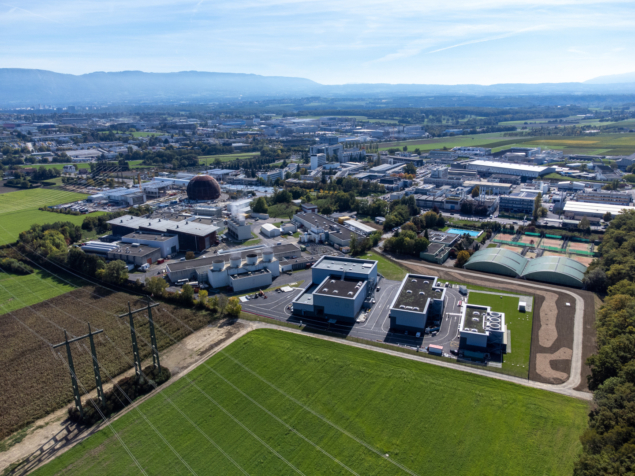
After five years of arduous and continuous activity, the main civil-engineering works for the High-Luminosity LHC project (HL–LHC) are on track to be completed by the end of the year. Approved in June 2016 and due to enter operation in 2029, the HL-LHC is a major upgrade that will extend the LHC’s discovery potential significantly. It relies on several innovative and challenging technologies, including new superconducting quadrupole magnets, compact crab cavities to rotate the beams at the collision points, and 80 m-long high-power superconducting links, among many others.
These new LHC accelerator components will be mostly integrated at Point 1 and Point 5 of the ring, where the two general-purpose detectors ATLAS and CMS are located, respectively. As such, the HL-LHC requires new, large civil-engineering structures at each site to house the services, technical infrastructure and accelerator equipment required to power, control and cool the machine’s new long-straight sections.
Connections
At each Point, the underground structures consist of a vertical shaft (80 m deep and 10 m in diameter) leading to a service cavern (16 m in diameter and 46 m long). A power-converter gallery (5.6 m in diameter and 300 m long), two service galleries (3.1 m in diameter and 54 m long), two radio-frequency galleries (5.8 m in diameter and 68 m long), as well as two short safety galleries, complete the underground layout. The connection to the LHC tunnel will be made via 12 vertical cores (1 m in diameter and 7 m deep), which will be drilled later and completed during long-shutdown 3 after the removal of the existing LHC long-straight sections.
The two sites generated 120 jobs on average from 2018 to 2021, solely for companies in charge of civil-engineering construction
Luz Anastasia Lopez-Hernandez
The surface structures consist of five buildings. Three are constructed from reinforced concrete to house noisy equipment such as helium compressors, cooling towers, water pumps, chillers and ventilation units. The other two buildings have steel-frame structures to house electrical distribution cabinets, a helium refrigerator cold-box and the shaft access system. The buildings are interconnected via buried technical galleries.
The HL-LHC civil-engineering project is based on four main contracts. Two consultancy service contracts are dedicated to the design and construction administration: Setectpi-CSD-Rocksoil (ORIGIN) at Point 1 and Lombardi-Artelia-Pini (LAP) at Point 5. Two supply contracts are dedicated to the construction of both the underground and surface structures: Marti Tunnelbau – Marti Österreich – Marti Deutschland (JVMM) at Point 1 and Implenia Schweiz – Baresel – Implenia Construction (CIB) at Point 5.
In total, 92,000 m3 of spoil has been excavated from the underground structures, while 30,000 m3 of concrete and 5000 tonnes of reinforcement-steel were used to construct the underground structures. At Point 5, based on the experience of civil engineering for the CMS shaft, groundwater infiltration was envisaged to make HL-LHC shaft excavation difficult. A different execution methodology and a dry summer in 2018 made the task easier, although the discovery of unexpected hydrocarbon layers (not seen during the CMS works) added some additional difficulties in the management of the polluted spoil. At Point 1, the expected quantity of spoil polluted by hydrocarbon was managed accordingly. The construction of the surface structures, meanwhile, required 6 km of anchor piles, 15,000 m3 of concrete, 1400 tonnes of reinforcement-steel and 700 tonnes of steel frames.
Opportunities
“The two sites generated 120 jobs on average from 2018 to 2021, solely for companies in charge of civil-engineering construction,” says Luz Anastasia Lopez-Hernandez, head of the project-portfolio management group of the site and civil-engineering department.
Special care was taken to limit worksite nuisance with respect to CERN’s neighbours. Truck wheels were systematically washed before leaving the worksites, and temporary buildings were erected on top of the shaft heads to limit the noise impact of the excavation work. The only complaint received during the construction period was related to light pollution at Point 5, after which it was decided to limit worksite lighting during nightfall to the minimum compatible with worker safety. As the excavation of the two shafts started in 2018 in parallel with LHC operation, special care was taken to limit the vibration level by using electrically driven road-header excavators.
The COVID-19 pandemic, which, among other things, required the two worksites to be closed for several weeks in 2020, caused a delay of one-to-two months with respect to the initial construction schedule. The Russian Federation’s invasion of Ukraine also impacted activities this year by delaying some deliveries.
“The next step is to equip these new structures with their technical infrastructures before the next long shutdown, which will be dedicated to the installation of the accelerator equipment,” says Laurent Tavian, work-package leader of the HL–LHC infrastructure, logistics and civil engineering.







